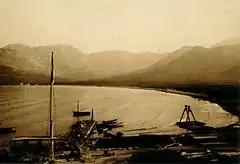Blockade of Montenegro
In the Blockade of Montenegro (10 April – 14 May 1913) a multi-national naval squadron summoned by the Great Powers and under the command of Sir Cecil Burney blockaded the Montenegrin ports. The purpose of the blockade was stopping Montenegrin reinforces and supplies from reaching the Albanian coast.
| Blockade of Montenegro | |||||
|---|---|---|---|---|---|
| Part of the First Balkan War | |||||
 Port of Bar under construction, c. 1905–1916 | |||||
| |||||
| Belligerents | |||||
|
|
| ||||
| Commanders and leaders | |||||
| Strength | |||||
| Multi-national naval squadron, including Austrian ships Aspern and Zenta, British ships Dublin and the 3rd Battle Squadron, French ship Edgar Quinet, German ship Breslau, and Italian ship Ammiraglio di Saint Bon | |||||
History
During the First Balkan War, the Great Powers decided that the disputed region should be given to the newly independent kingdom of Albania, created as a neutral country under international administration, and they decided to carry out a blockade to reinforce this decision.[6][7] As Montenegro continued their siege of Scutari, the Great Powers decided to implement the blockade, which was declared on 10 April 1913.[7] The purpose was to prevent Serbian supplies and reinforcements from reaching the Albanian coast.[7] The blockade, consisting of a "multi-national naval squadron",[6] lasted from 10 April until 14 May 1913.[8]
Among the ships involved in the blockade were the Austro-Hungarian SMS Aspern, SMS Erzherzog Franz Ferdinand, SMS Radetzky, SMS Salamander, SMS Zenta and SMS Zrínyi, the British HMS Africa, HMS Britannia, HMS Commonwealth, HMS Dominion, HMS Hibernia, HMS Hindustan, HMS King Edward VII and HMS Zealandia (3rd Battle Squadron), HMS Dublin and HMS Darmouth,[2][3][9][10] the French Edgar Quinet and Ernest Renan,[2] the German SMS Breslau, and the Italian Ammiraglio di Saint Bon and Francesco Ferruccio.[1]
The block initially extended along the Montenegrin-Albanian coast from Bar (now in Montenegro) up to the outlet of the river Drin, near Shëngjin, in present-day Albania.[1] On 23 April, Burney extended the block up to Durrës in Albania.[2]
Pressured by the international blockade, Serbia withdrew its army from Scutari, which was subsequently occupied by a joint Allied ground force.[11]
References
- Rivista nautica rowing, yachting, Marina militare e mercantile. Tip. L. Roux e C. 1895. p. 127.
- Hooton, E.R. (2017). Prelude to the First World War The Balkan Wars 1912-1913. Fonthill Media. p. 111. Retrieved 17 February 2023.
- Heathcote, T.A. (2002). British Admirals of the Fleet 1734-1995 A Biographical Dictionary. Leo Cooper. p. 37. ISBN 9780850528350.
- Tucker, Spencer (2003). Who's Who in Twentieth Century Warfare. Taylor & Francis. p. 235. ISBN 9781134565153.
- Ueberall illustrierte Zeitschrift für Armee und Marine · Volume 15 (in German). Boll u. Pickardt. 1913. p. 699.
- Heathcote, T.A. (2002). British Admirals of the Fleet 1734-1995 A Biographical Dictionary. Leo Cooper. ISBN 9780850528350.
- Schmidl, Erwin A. (1999). "The international operation in Albania, 1913–14". International Peacekeeping. 6 (3): 1–10. doi:10.1080/13533319908413782.
- Grewe, Wilhelm Georg (2000). Byers, Michael (ed.). The Epochs of International Law. Walter de Gruyter. p. 529. ISBN 9783110153392.
- Burt, R.A. (2013). British Battleships, 1889-1904. Pen & Sword Books Limited. p. 292. ISBN 9781848321731.
- Ueberall illustrierte Zeitschrift für Armee und Marine · Volume 15 (in German). Boll u. Pickardt. 1913. p. 699.
- Vego, Milan N. (1996). Austro-Hungarian Naval Policy, 1904–14. Abingdon: Taylor & Francis. pp. 151–152. ISBN 978-0-7146-4209-3.